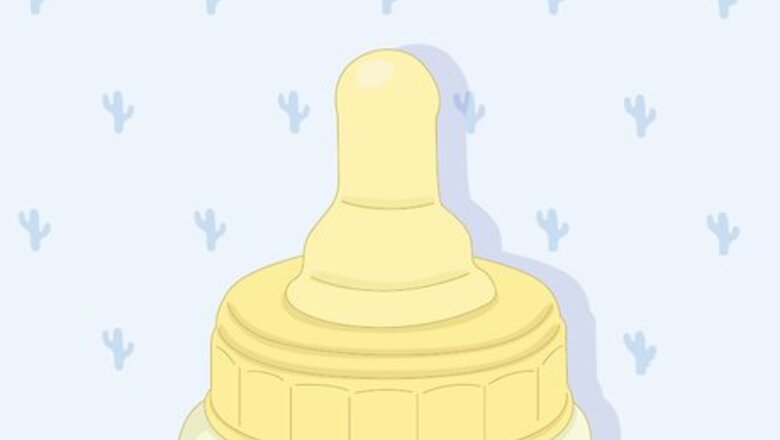
views
Preparing a Bottle
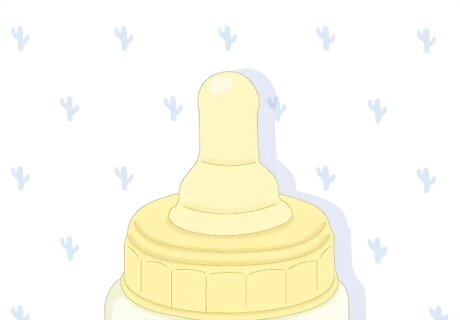
Start with a slow-flow nipple when your baby is very small. Very young newborns in the first days are more easily able to choke when they’re eating. Start with the lowest number level of nipple available with the bottles you have. As your baby gets older, you can increase the flow speed to suit their preference.

Wash your hands before preparing a bottle. Rinse your hands under warm running water in a sink. Apply hand soap to your hands and rub the soap between your hands and fingers for 20 seconds. Rinse the soap from your hands completely, and dry them on a clean towel.
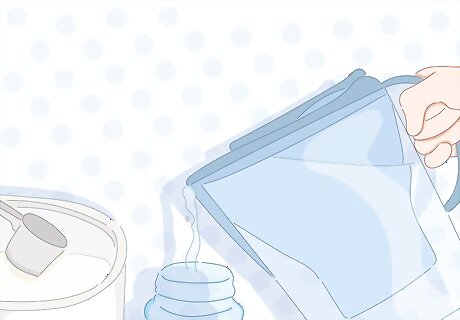
Mix your formula powder with clean water according to package instructions. If you’re using formula, read the package instructions on mixing the formula powder with water, and follow the instructions exactly. Do not use more formula powder than what is called for in the instructions; doing so can give your baby painful gas or cause them to become dangerously dehydrated. Breastmilk is the healthiest option for feeding your newborn. If you are able to breastfeed your baby or pump expressed milk to feed them in a bottle, you should do so. If you are unable to breastfeed, pump your breastmilk, or purchase donated breastmilk, infant formula is the only safe alternative for feeding your baby. Do not feed an infant under 6 months old cow’s milk, other animal milk, or milk alternatives such as soy milk. Breastmilk and infant formulas are the only safe milks for babies under 6 months. Be sure that you have clean, safe drinking water to use for your formula.
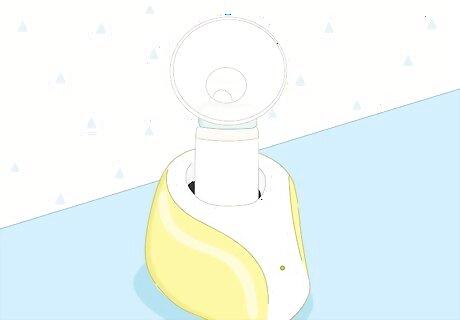
Warm cold breastmilk in a bottle warmer or pan of warm water. If you are using expressed breastmilk to feed your baby, they may prefer it to be warmed if it has been refrigerated or thawed from the freezer. Warm a pan of water on the stove until it is warm but not boiling, then remove it from the heat. Place the bottle of milk in the pan and allow it to warm until it’s no higher than 100 °F (38 °C). You can use a clean food thermometer to check the temperature if you like. Do not warm your bottle directly on the stove, use a microwave, or let the milk get higher than 100 °F (38 °C). Doing so increases the risk of burning your baby’s mouth. It is safe to feed your baby cold or room temperature breastmilk. Many parents warm breastmilk after it’s been refrigerated or frozen to make it closer to the temperature of milk during breastfeeding, and because their babies prefer it, but it is not necessary to warm it. There are commercial bottle warmers available for sale that you can use if you prefer. Follow the manufacturer’s instructions on using it if you have one.

Test the flow and temperature of your milk or formula on your arm. Place the nipple and cap securely on your bottle. Turn the bottle upside down and allow a few drops of milk or formula to come out onto your forearm. Check that the drops feel cool or warm but not hot, and that they flow steadily from the bottle in continuous drips. If you have to squeeze the nipple or shake the bottle to get drops to come out, the hole may be blocked. Check the nipple hole to be sure it is clean and unobstructed. If the milk or formula seems to pour out of the nipple, the hole may be damaged. Replace the nipple with a new, sterilized nipple before feeding your infant. It's much better to give your baby breastmilk or formula that's cooler than to burn their tongues with breastmilk or formula that's too hot.
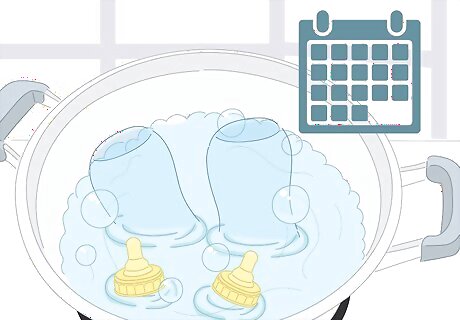
Sterilize your bottle and nipple daily. There are several ways to sterilize bottles, but you can submerge your bottle, nipple, and any other pieces in boiling water for 5 minutes as a simple method. You can also use the sanitize setting on your dishwasher. Check the manufacturer’s label about the safety of sterilizing plastic bottles. Some plastics contain chemicals that should not be exposed to high heat. Many parents choose glass bottles for this reason. You should sterilize anything going into your newborn’s mouth once per day until their immune system becomes stronger after a few months. You can clean the bottles with regular dish soap and water between sterilizations. Talk with your baby’s pediatrician about when you can decrease how often you sterilize bottles.
Feeding Your Baby
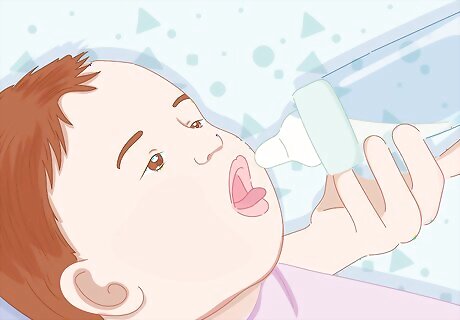
Feed your baby when they show hunger cues. Newborns show that they are hungry by moving their heads from side to side, opening their mouths, sticking out their tongues, sucking on their fingers or fists, or trying to suck on anything that comes near their cheek. Crying is actually a late hunger cue, and it’s best to try to feed your baby before they are crying because it’s easier to calm them down to eat. Babies sometimes fuss or cry for reasons other than hunger. If your baby is fussing or crying just an hour after a good feeding, they may need a diaper change, be tired, bored, overstimulated, or too hot or too cold. You can check these other things before trying to feed them again.
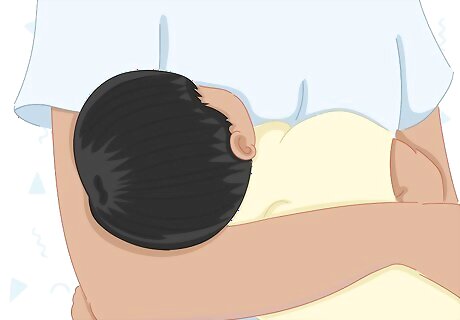
Hold your baby in a semi-upright position and support their head. When it’s time to feed your baby, sit in a comfortable chair and hold them with their head in the crook of your arm and your hand down around their bottom. Their head should be comfortably above their belly. This is called the cradle position Never feed your baby when they’re lying flat on their back. This can cause them to choke or cause them to get ear infections. You can also hold your baby on your lap and let their head rest against your chest when you feed them. Just be sure to support their head with your hands and reposition them if they start to slide down off your chest. This position works well for babies that have reflux because they are more upright.
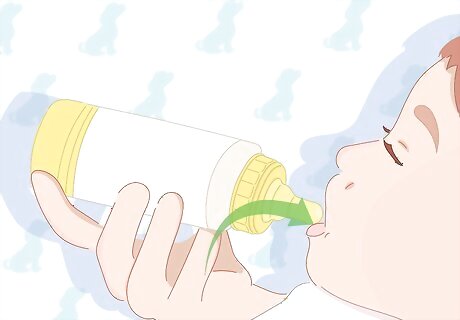
Place the nipple against your baby’s lower lip to prompt them to open their mouth. If your baby is hungry, they will open their mouths to accept something that’s placed on their lower lip. Gently place the bottle nipple against their lower lip. If your baby turns their head away, they may not be hungry at this time, or they may be too uncomfortable to eat right now. Check for other reasons that they are fussing or crying, such as their diaper, before trying to feed them again.
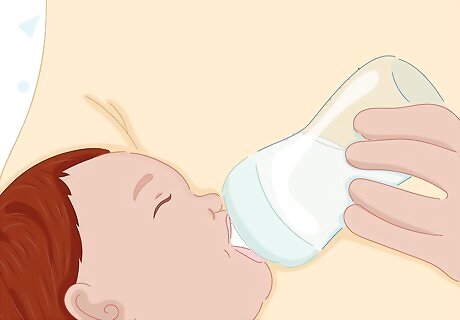
Tilt the bottle to keep the nipple full of milk or formula. As you feed your baby, you want the nipple to stay full so that your baby doesn’t suck air. Keep the bottle tilted with the bottom pointed up while it’s in your baby’s mouth.

Allow your baby to draw the nipple into their mouth and suck. As you bring the nipple up into your baby’s open mouth, they will latch onto it and start to suck and swallow. This is their natural response when they are hungry. When they start to slow their sucking and swallowing, bring the nipple partially out of their mouth and allow them to draw it back in again. Allowing your baby to draw the nipple back into their mouth throughout the feeding is called “pacing” the feeding, and it simulates the starting and stopping of milk flow during breastfeeding. Your baby will eagerly draw the nipple back into their mouth as you move it away if they are still hungry. If they become upset at having the nipple moved out of their mouth, you can tilt the bottle downward momentarily to slow or stop the flow of liquid. Tilt the bottle back up as your baby starts sucking again so they suck less air.

Look into your baby’s eyes and cuddle them or talk to them while feeding. To add to the feeding experience and bond with your baby, you can talk to them, cuddle them, and look into their eyes while they drink. They will look forward to feeding moments not only to satisfy their hunger, but as a way to spend time feeling loved by you. At night time, to encourage your baby to go back to sleep, you may want to decrease how much you talk to them during feeding. You can cuddle and look at them, but try to keep other interactions to a minimum. It is also helpful to keep the lights off or dim during night feedings.

Follow your baby’s lead for how much and how often to feed them. Little babies differ from one another in how much and how often they need to eat. In general, a formula-fed newborn will eat 2–4 fl oz (59–118 mL) of formula 6-8 times every 24 hours up until 2 months old. Babies who drink expressed breastmilk may need to eat more often, as breastmilk is metabolized faster than formula. Don’t worry if your baby doesn’t want to finish a bottle, or if they want more after they finish a bottle. Sometimes they’ll want to eat less, and sometimes they’ll have a growth spurt and need more. The suggested feeding amount is a general guideline, and if they are drinking between 12–32 fl oz (350–950 mL) of milk within 24 hours, they are eating enough. The amount your baby eats will increase at 2 months old to approximately 5–6 fl oz (150–180 mL) of formula 5-6 times per day, or 25–36 fl oz (740–1,060 mL) in 24 hours. At 3-5 months old, the amount increases again to 6–7 fl oz (180–210 mL) 5-6 times per day. Again, babies drinking expressed breastmilk may need to eat more frequently.
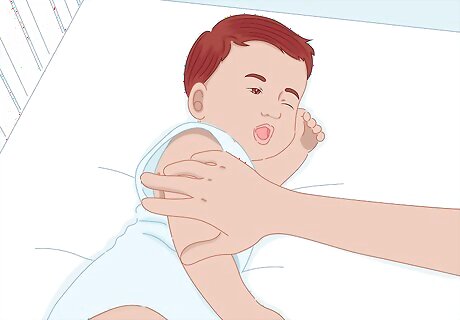
Wake your baby every few hours to eat during their first few weeks of life. Tiny babies have tiny tummies, and they also like to sleep a lot: to ensure proper weight gain during their first month, you may need to wake your baby if they are sleeping for long chunks of time. Wake a breastfed baby every 3-4 hours and a formula-fed baby every 4-5 hours to eat until they are 1 month old. After 1 month, as long as your baby is gaining weight well, you do not need to wake them up to feed them. If your baby’s doctor is concerned about your baby’s lack of weight gain, follow their recommendations for feedings.
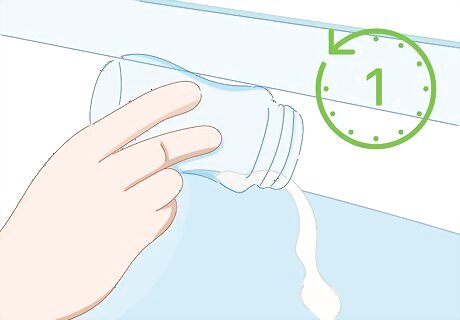
Throw away any unused formula or breastmilk from each feeding after 1 hour. When your baby seems finished eating, you can try burping them again to see if they’ll eat more after a burp. If they still are uninterested in eating more, you can keep the bottle for 1 hour after you started the feed in case they want more within the hour. When the hour is up, throw away the milk or formula away by pouring it down the sink drain. Don’t store a leftover bottle for future use longer than 1 hour. It can become contaminated quickly after it’s been sucked on. Throw the milk away and wash the bottle before you use it again.
Burping Your Baby
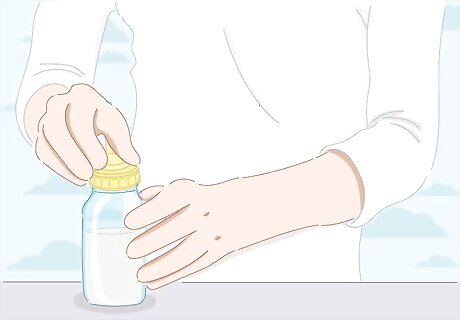
Set the bottle down and try to burp every 2–3 fl oz (59–89 mL) of consumed milk. Bottle-fed infants suck a lot more air during a feed than infants eating from a breast, so it’s important to burp them frequently during a feed. Burping them throughout the feed makes them more comfortable and more likely to finish their bottle. Try to burp your baby at least after every 2–3 fl oz (59–89 mL) of milk or formula they drink, or more frequently if they seem squirmy, fussy, or otherwise uncomfortable.

Drape your baby over your shoulder. To burp your newborn, hold them with their head high up and resting over your shoulder, supporting their head the whole time. Holding them this high places slight pressure on their tummy and eases the air out through a burp.
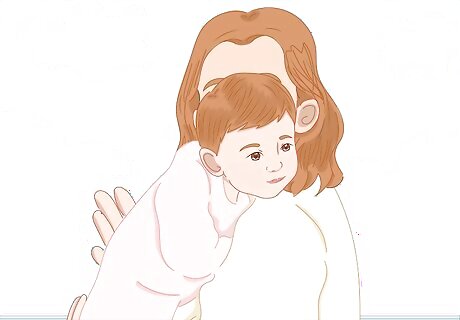
Firmly pat or rub their back. To help your baby’s burp come out, put some pressure on their back by patting or rubbing it. Your baby will be calmed by the repetitive patting or rubbing, and more likely to burp.
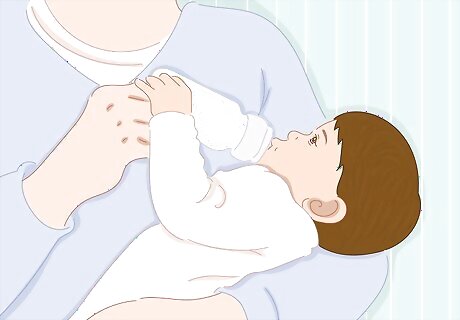
Resume feeding after a couple minutes even if your baby doesn’t burp. If your baby hasn’t finished their bottle, you can try feeding them again after about 2 minutes of trying to burp them whether they actually burp or not. If they are not interested in eating more but seem fussy, you can try burping them again or check to see if they need a diaper change. If they seem content but uninterested in eating, they are probably full and have finished eating for this feed.



















Comments
0 comment